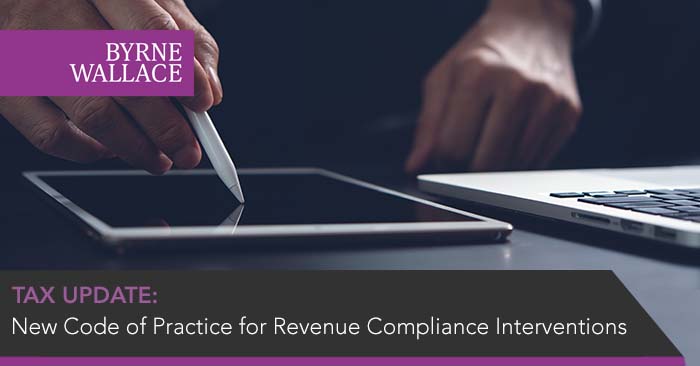New Code of Practice for Revenue Compliance Interventions
Monday, 23 May 2022
Introduction
The Revenue’s new Code of Practice for Revenue Compliance Interventions is now in force. The new Code sets out details of Revenue's revised framework for tax compliance interventions, which will apply to all interventions notified on or after 1 May 2022. The Code applies to all taxes and duties except for customs duties.
The new Code introduces substantial changes to Revenue’s approach, which are intended to encourage voluntary review and self-correction by taxpayers. The changes will result in reduced opportunities to make unprompted disclosures to Revenue once an intervention has commenced, meaning that significantly increased penalties may be payable.
The previous (2019) version of the Code will continue to apply to compliance interventions notified before May 2022.
Intervention Levels
The new Code is intended to provide a graduated response to tax risk and non-compliance. From 1 May 2022, all Revenue compliance intervention notifications will state whether the intervention is at Level 1, 2 or 3.
This does not necessarily mean there will be sequential escalation between levels. The intervention will be determined by the nature of the risks identified by Revenue, and a Level 2 or 3 intervention can be initiated without any previous notification. Interventions may also be escalated by Revenue where appropriate.
Level 1
Level 1 interventions are aimed at supporting tax compliance by reminding taxpayers of their obligations. A Level 1 intervention is broad-based and only occurs where Revenue has not already engaged in any detailed review of the relevant matter. Examples include:
- Reminder notifications of outstanding tax returns
- Requests to self-review a tax return
- Profile interviews
- Engagement with businesses under the Cooperative Compliance Framework (CCF)
On receipt of a Level 1 intervention, taxpayers retain the ability to make an “unprompted” qualifying disclosure or a self-correction without penalty (if within the applicable time limits) in relation to any tax default.
Level 2
Level 2 interventions confront compliance risks based on the circumstances and behaviour of taxpayers. There are two types of Level 2 interventions:
- Risk reviews
- Audits
When notified of a Level 2 intervention, a taxpayer loses the opportunity to make an “unprompted” qualifying disclosure or a self-correction without penalty, but may make a “prompted” qualifying disclosure within 28 days of the notification. The penalties due following a “prompted” disclosure are generally higher than those due following an “unprompted” disclosure – see below.
Taxpayers can also request additional time (up to 60 days) to prepare a disclosure if they submit a “notice of intention” to make a disclosure within 21 days of the notification from Revenue.
Risk Review
The “risk review” is a creation of the new Code, and is a focused intervention examining a particular risk or small number of risks on a tax return where a full audit is not warranted. A risk review will generally be a paper-based intervention but scope is also available for a reviewer to visit the taxpayer’s premises or hold a video call where the situation requires.
Any qualifying disclosure must cover not only the matter which is the subject of the risk review, but also:
- Where there is careless behaviour, all liabilities in respect of the relevant tax and period covered by the risk review; and
- Where there has been deliberate default, all liabilities in respect of all taxes and periods.
It seems that risk reviews are essentially likely to replace the “aspect query” procedure, which does not exist under the new Code. However, the opportunity for penalty mitigation under a risk review is less because taxpayers lose the opportunity to make an “unprompted” disclosure. Based on the different penalties due for “unprompted” and “prompted” disclosures (see below), this means the minimum penalties following a focused intervention by Revenue are likely to increase:
- For careless behaviour without significant consequences, from 3% to 10%; and
- For careless behaviour with significant consequences, from 5% to 20%.
Once the risk review has commenced, additional information may emerge which requires the widening of the review to other periods and/or taxes. As such, the risk review may be escalated to a full audit. In this case, the taxpayer will receive 28 days’ notice to make a prompted disclosure in relation to any new periods/taxes covered by the audit.
Level 3
Level 3 interventions (Revenue investigations) focus on tackling high risk practices and cases displaying risks of suspected fraud and tax evasion.
A Revenue investigation will be initiated where Revenue believes, from a review of available information, that serious tax or duty evasion may have occurred, or a Revenue offence may have been committed.
A taxpayer is unable to make a qualifying disclosure once notified of a Level 3 intervention. There have not been significant changes to this level of intervention under the new Code.
Summary of Revenue compliance interventions
| Level 1 | Level 2 | Level 3 | |
| Objective | Support tax compliance | Challenge non-compliance | Tackle high risk cases/practices displaying risks of suspected fraud/tax evasion |
| Types of intervention |
|
| Revenue investigation |
| Disclosure position |
| Prompted qualifying disclosure within:
| No opportunity to make qualifying disclosure |
.
Other changes under the new Code
Some further changes under the new Code (reflecting changes in Finance Act 2021) include:
- Settlements of up to €50,000 (excluding interest and penalties) are now excluded from publication in Revenue’s quarterly list of tax defaulters. Publication was previously only excluded where the total settlement did not exceed €35,000 (including interest and penalties).
- Qualifying disclosures may now be made in relation to certain offshore matters, which were previously excluded.
- Self-corrections must now be notified in writing to Revenue (although this can be done via Revenue Online Service); submitting an amended tax return is not sufficient.
Penalties due
The penalties due for an underpayment of tax will depend on a number of factors:
- Whether the taxpayer has made a “qualifying disclosure” to Revenue (i.e. a disclosure that contains a declaration signed by the taxpayer and is accompanied by payment of the tax and interest arising);
- Whether this is “prompted” or “unprompted” (which will depend on whether it is made before notification of a Level 2 compliance intervention);
- Whether the behaviour leading to the default was deliberate or careless, and if careless whether it had a significant impact on the taxpayer’s tax liability;
- Whether full co-operation is given to the Revenue intervention; and
- The number of previous qualifying disclosures made by the taxpayer.
Where a qualifying disclosure is accepted, as well as mitigating penalties, the settlement will not be published in Revenue’s quarterly list of tax defaulters and Revenue will not initiate an investigation with a view to criminal prosecution.
The applicable penalties are set out in the table below.
| Disclosures | Category | Penalty % Full cooperation not given by taxpayer | Penalty % Prompted Qualifying Disclosure and full cooperation | Penalty % Unprompted Qualifying Disclosure and full cooperation |
| All qualifying disclosures in this category | Careless behaviour without significant consequences | 20% | 10% | 3% |
| First qualifying disclosure in these categories | Careless behaviour with significant consequences | 40% | 20% | 5% |
| Deliberate behaviour | 100% | 50% | 10% | |
| Second qualifying disclosure in these categories | Careless behaviour with significant consequences | 40% | 30% | 20% |
| Deliberate behaviour | 100% | 75% | 55% | |
| Third or subsequent qualifying disclosure in these categories | Careless behaviour with significant consequences | 40% | 40% (no reduction) | 40% (no reduction) |
| Deliberate behaviour | 100% | 100% (no reduction) | 100% (no reduction) |
Given Revenue’s increasingly robust and targeted approach to tax compliance interventions and the reduced opportunity to mitigate penalties once Revenue action has commenced, it is more important than ever that taxpayers take steps to self-review their tax affairs on an on-going basis to identify any tax risks.
Taking pro-active steps to correct any errors should ensure that penalties are kept to a minimum and the reputational risk of publication on Revenue’s tax defaulters list is avoided.
The ByrneWallace tax team has significant experience advising clients on pro-actively managing tax risk, responding to Revenue compliance interventions and regularising their tax affairs. Where agreement cannot be reached, we also assist taxpayers in resolving complex tax disputes, including by appeals to the Tax Appeals Commission.
For more information or advice, please contact Lee Squires or any member of the ByrneWallace Tax Advisors team.

